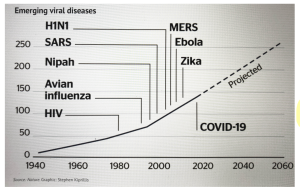When Hermann Kahn wrote Thinking the Unthinkable he was considering the prospect of nuclear war. The collapse of civilisation is a similar topic and one that people tend to shy away from. Yet if global collapse is inevitable, why bother with the Futures field? Continue reading….
A 21st Century View of Pandemics and Biosecurity
 Dark Winter is the story of one woman’s journey through pandemics and biosecurity in the 21st Century. It is a refreshing account that stands in stark contrast to the paucity of earlier work. It also is a kind of restrained manifesto that makes a case for using appropriate methods to understand and respond to dynamic changes in the biosphere, particularly in relation to viruses and other pathogens. The ‘dark winter’ of the title refers to the possibility of new knowledge being mis-used in ways that create new dangers and risks. Macintyre and her colleagues, however, make a strong case for caution and responsible use of high tech in this critical area. Interested readers can look up the Epiwatch site and quickly understand how specialists in the field are using up-to-the-minute information and guidance. Read original piece from Compass Here.
Dark Winter is the story of one woman’s journey through pandemics and biosecurity in the 21st Century. It is a refreshing account that stands in stark contrast to the paucity of earlier work. It also is a kind of restrained manifesto that makes a case for using appropriate methods to understand and respond to dynamic changes in the biosphere, particularly in relation to viruses and other pathogens. The ‘dark winter’ of the title refers to the possibility of new knowledge being mis-used in ways that create new dangers and risks. Macintyre and her colleagues, however, make a strong case for caution and responsible use of high tech in this critical area. Interested readers can look up the Epiwatch site and quickly understand how specialists in the field are using up-to-the-minute information and guidance. Read original piece from Compass Here.
Foresight in Action? A Mid-1990s View of Viral Pandemics
 One of the areas in which the benefits of careful foresight are most clearly revealed is in relation to new items ‘in the pipeline.’ That is, phenomena that careful environmental scanning suggest will have a range of social impacts. If these impacts are simply allowed to occur, they may well result in a variety of social costs, some of them heavy. On the other hand, if they are acknowledged well before they become unavoidable, this knowledge can often be employed to mitigate the effects or even avoid them entirely….Read more…
One of the areas in which the benefits of careful foresight are most clearly revealed is in relation to new items ‘in the pipeline.’ That is, phenomena that careful environmental scanning suggest will have a range of social impacts. If these impacts are simply allowed to occur, they may well result in a variety of social costs, some of them heavy. On the other hand, if they are acknowledged well before they become unavoidable, this knowledge can often be employed to mitigate the effects or even avoid them entirely….Read more…
HG Wells, the World Brain and the Human Future
Herbert George Wells is mainly remembered as a writer of speculative fiction, although during his lifetime he was perhaps more widely known as a social critic. His fiction and non-fiction, however, both expressed aspects of a strongly held progressive global vision. He had a pervasive sense that humanity was on the cusp of a ‘new era.’ Yet he was equally aware than if it was to turn out well it was becoming urgent to address what he called ‘the world problem.’ By which he meant the growing number of interlocking problems that were becoming ever clearer and more concerning. He realised that solutions had to be conceived in a coherent and organised way. Yet he was constantly frustrated by what he regarded as the inadequacy of decision making within contemporary social and economic structures. He believed that politicians, diplomats, social administrators and, indeed, universities all fell short of what was required. Continue reading…
Reflections on the Limits to Growth (1972)
Back in the early 1970s, while living and working in Bermuda, I was becoming increasingly perplexed by the way what had been a sub-tropical island paradise was steadily turning into a busy mid-ocean metropolis. Primeval Bermuda was giving way to acres of houses, resorts, golf courses and so on. The pink coral sand of its world-class beaches were becoming polluted by oil and floating debris. The bird hosts of the past were long gone. What was the underlying cause? Growth. Obviously. But, I wondered, what kind of growth, and how could it be moderated? In this context, the Limits to Growth (LtG) study was a pioneering attempt to find answers and begin the search for solutions. But, very unfortunately, these efforts, and those that followed over the following decades, were viewed by powerful actors as threats and every effort was made to undermine and delegitimise them. This article was written for Compass, the quarterly journal of the Association of Professional Futurists (APF), before I acquired a new work, Limits and Beyond, that takes a fresh view of the LrG over the past 50 years. A response to this new anthology will appear here in due course. In the meantime here are some reflections on the significance of the original work then and now. Continue reading…
Deep Time and Futures
In April 2022 University of Zurich scientists went public about an extraordinary discovery. They had uncovered several 205-million-year-old fossils, the remains of giant oceanic creatures known as Ichthyosaurs. These remarkably intact fossils, however, did not emerge from strata deep below the surface but from a site 2,700 meters above sea level in the Swiss Alps. One of them is shown in the image below. It had grown to an estimated length of 20 meters and would have weighed some 80 tons. It has been described as ‘the largest animal that ever lived.’
Fossils at 2,700 meters makes you stop and think. It’s only natural to wonder about what caused them to be there in the first place. We’re far more used to archaeologists digging deep below the present-day surface in their search for fragments of past life. Within our fragmentary, occluded, everyday existence we know the world as it currently appears – a familiar assembly of landscapes and features that change very slowly, if at all. In some distant, abstract corner of our minds we also know that in the past everything was different. But, aside from a few specialists, we tend not to think about the vast disruptions, upheavals and aeons of erosion that sculpted the foundations of the world and continue to do so.
Shifts of perspective can de-familiarise things and illuminate the world in unexpected ways. In this case the discovery provided fresh impetus for the ‘deep dive’ into the Earth’s distant past that had preoccupied me for a while. The following short article is the first product of these efforts. It’s a work in progress that outlines some of the issues, as I see them, for the practice of Futures Studies and Applied Foresight in these troubled times. It appeared in the May 2022 issue of Compass, the on-line journal of the Association of Professional Futurists. I’m grateful that the piece was made available so that it could be re-presented here in this form. Read article…
Understanding the Global Emergency
The global emergency has been emerging since at least the early 1970s but most people, especially the rich and powerful, have chosen either not to see it or pretend it does not exist. Clearly, it’s a challenging subject but, at the same time, there’s no shortage of evidence to support the view that something unprecedented and profoundly disturbing is happening. Like other Futurists I’ve made various attempts to summarise the evidence and identify ways out of the trap humanity has created for itself. It goes almost without saying, however, that work of this kind gains very little traction either with the general public or with those currently operating the systems of governance and regulation that are supposed to keep things on track.
I’ve known Richard Eckersley for over 30 years in part because our work runs in parallel but occasionally overlaps when one of the other of us reaches out in some way. Therefore, I was not surprised when I received a copy of his recent paper exploring the deep divides that run through the damaged soul of America. One of the many strengths of his work is that much of it is based on listening to people via in-depth surveys carried out in several countries. Hence the thesis he presents here is not merely personal but one that incorporates the insights, feelings and concerns of many others. What emerges is a thoroughly original and very perceptive analysis of ‘what is going on’ as the tensions and strains in people’s inner lives interact with those in the outer world to produce a surprisingly coherent pattern. This is work of the highest quality – which is why I sought the author’s permission to reproduce it here.
Richard’s view is essentially that there’s a widening gap between the science and politics of human progress on the one hand and the increasingly destructive modes of development that have become normalised over the last fifty or so years on the other. I came to similar conclusions myself some years ago. But what I was less clear about then was the nature of the social and human drivers involved. Needless to say, the evidence points conclusively toward the steady and irreversible demise of the ‘official future.’ What, then, can replace it? Read the paper and see for yourself.
Should you wish to discuss it further, the author’s contact info is included at the end of the piece. Read Richard’s paper here.
(If, for some reason, the link does not work you can also find the paper via: Foresight International -> Archive -> Global Emergency ->)
Making Headway During Impossible times
When I began the Five Steps to Recovery series I had in mind several specific topics, three of which subsequently appeared. As time went by, however, I felt that Covid-19 had already taken us into new territory, which implied that my original concept for the series no longer seemed appropriate. Part four was going to address the question of what ‘story’ was arguably operating in the background that would help explain what was going on. Indeed, I addressed this very issue in a FuturePod interview on ‘skewed narratives’ late last year. You can find that episode here: https://www.futurepod.org/podcast/ep-113
At the same time, I’d also been working with Luke van der Laan and colleagues at the University of Southern Queensland on Deleting Dystopia, a book that seeks to understand why the IT revolution became such a disaster and what can be done about it. Once published, it was appropriate to say so in what became the most recent FI News. All well and good, you might say, until the Ukraine crisis blew up in our faces and re-kindled many of the fears and nightmares that we’d hoped lay well behind us. Very unfortunately, that’s clearly not the case…
I decided to re-present a paper I wrote a decade ago for the Journal of Integral Theory and Practice which was later revised as chapter 15 of To See With Fresh Eyes: Integral Futures and the Global Emergency. It addresses some of the background issues that have fed into the global crisis and helped bring us to this point. You can find the paper here.Building on this, my wife, Laurie, came across an article by Robb Smith on the Integral+Life website. I can’t reproduce it here due to copyright restrictions, but I can share the link. Point being that anyone who wants a positive in-depth Integral analysis of what is happening right now in Ukraine can find it right here. Here’s a brief quote that really caught my attention:
Every structure of evolution has within it a set of contradictions that eventually become the fuel for solving the very problems it creates.
You can find Robb’s article here: https://integrallife.com/russia-is-catalyzing-the-transformation-age/
Open Access Launch of Deleting Dystopia
Deleting Dystopia: Reasserting Human Priorities in the Age of Surveillance Capitalism
The IT revolution has brought many surprises.
Among them is the fact that intensive surveillance and the related abuse of personal data have fallen into the hands of powerful digital oligarchies. Accounts of the increasingly repressive uses of advanced technologies and the subsequent ‘dumbing down’ of entire populations cast dark shadows over our future prospects that are beginning to look increasingly dystopian.
Deleting Dystopia confirms that these existential threats are real. But, in place of apathy and fatalism, Slaughter explores ways of understanding them, conceptualising solutions and identifying viable strategies. Taken seriously and widely applied, he suggests that the latter can help us avoid the worst of digital authoritarian futures in favour of those founded on humanly viable values and practices.
Access the book here.
The author discusses the new book with Luke van der Laan here.
The artwork in the book, which was created by Samara Hoffmann, can be accessed and reused under a Creative Commons Non-Commercial ShareAlike licence. The cover is by Tara Mann.
Five Steps to Recovery
Part Three: Technology is Not the Answer
Humanity and technology have been intertwined from the earliest times. Many will recall how this evolving relationship was brilliantly portrayed at the beginning of Kubrick’s film, 2001, when an ape-like hominid threw a weaponised bone up into the air that dissolved into an elegantly turning space station. Popular histories often associate successive waves of new tech as evidence of ‘progress’ and ‘growth.’ Similarly, it’s often said that technology is neither ‘good’ nor ‘bad’ but capable of being used either way. Such views, however, don’t get us very far in part because they fail to engage with the default triumphalist myth of human development. Moreover, there’s plenty of evidence to show that technologies exert shaping influences upon their inventors and users, often in unexpected and unusual ways. It may be more helpful to think of these processes as cultural journeys that evoke an unfolding series of questions. —> Continue reading…



















